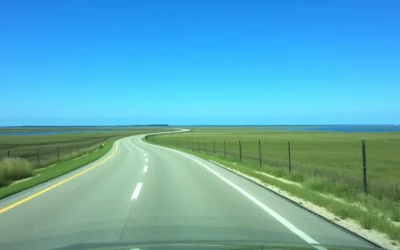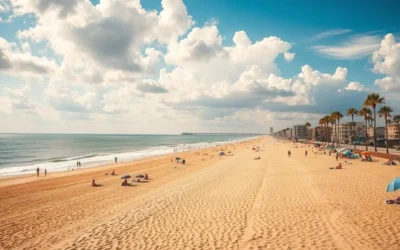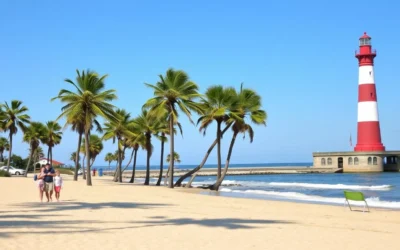✓ Accommodations✓ Flights✓ Rental Cars
Planning a trip to Charlottesville requires understanding the region’s distinct seasonal weather patterns to make the most of your visit.
The ideal time to visit is crucial for a memorable experience. Based on the tourism score, the best times to visit are for the entire month of June and from early August to early October.
Understanding the city’s climate variations throughout the year will help you determine the optimal time for your travel goals. Whether you’re visiting for outdoor adventures or cultural experiences, being aware of the weather conditions will enhance your trip.
Understanding Charlottesville’s Climate
Charlottesville’s climate is shaped by its unique geography, resulting in a diverse range of weather conditions throughout the year. The city’s location in the foothills of the Blue Ridge Mountains significantly influences its climate, with variations in temperature, precipitation, and cloud cover observed across different times of the year.
Geographic Influences on Weather
Charlottesville’s geography plays a crucial role in determining its weather patterns. The city’s proximity to the mountains affects temperature and precipitation, with areas at higher elevations experiencing cooler temperatures and potentially more rainfall. This geographic influence contributes to the region’s diverse microclimates, making some areas more prone to certain weather conditions than others.
The region’s terrain also impacts wind patterns and the movement of weather systems, further diversifying the local climate. Understanding these geographic influences is essential for predicting and preparing for various weather conditions during your visit.
Four Distinct Seasons
Charlottesville experiences four distinct seasons, each with its unique characteristics. The clearer part of the year begins around July 15 and lasts for 3.9 months, ending around November 13. Conversely, the cloudier part of the year starts around November 13 and lasts for 8.1 months, ending around July 15. This variation in cloud cover is a significant aspect of the local climate, influencing both temperature and precipitation patterns.
Each season brings its own set of weather conditions, from the warmth of summer to the cold of winter, and the mild temperatures of spring and autumn. Being aware of these seasonal changes can help you plan your activities and make the most of your time in Charlottesville.
Climate Change Considerations
Recent climate trends indicate that Charlottesville is experiencing more extreme weather events than historical averages, including hotter summers and more variable winter conditions. You may notice longer growing seasons and shifting precipitation patterns, which can affect traditional weather expectations for the region. For instance, there has been an increased frequency of heavy rainfall events, potentially impacting outdoor activities during traditionally drier months.
Additionally, winter snowfall patterns have become less predictable, with some years seeing minimal accumulation and others experiencing significant snow events. These climate change considerations are worth factoring into your travel plans, especially if you’re visiting during transitional seasons or planning weather-dependent activities.
Seasonal Overview: What to Expect Year-Round
As you plan your trip to Charlottesville, Virginia, understanding the seasonal variations will help you make the most of your visit. Charlottesville experiences a continental climate with four distinct seasons, each offering unique experiences and activities.
Temperature Patterns Throughout the Year
Charlottesville’s temperature varies significantly throughout the year. Summer months are warm, with average highs often reaching the mid-80s (°F). Winters can be chilly, with temperatures sometimes dropping below freezing. Spring and autumn are generally mild, making them ideal for outdoor activities.
The temperature fluctuations are a crucial factor in planning your trip. For instance, if you’re visiting in the summer, you can expect hot days, while winter visits require warm clothing.
Precipitation and Humidity Levels
Precipitation in Charlottesville is relatively evenly distributed throughout the year, with an average annual rainfall of around 40 inches. Summer months tend to be more humid, while spring and autumn are generally drier. Winters can see some snowfall, adding to the city’s charm.
Understanding the precipitation patterns can help you plan outdoor activities and pack accordingly. For example, carrying an umbrella during spring and summer is a good idea due to the potential for sudden showers.
Daylight Hours and Sun Exposure
Charlottesville experiences significant seasonal variation in daylight hours. The longest days occur around the summer solstice in late June, with nearly 15 hours of daylight. In contrast, winter days are much shorter, with December having just over 9.5 hours of daylight.

Daylight Saving Time (DST) affects sunrise and sunset times from mid-March through early November. During DST, which starts on March 9 and ends on November 2 in 2025, the evening daylight is pushed later. You can enjoy extended daylight in the summer, with sunrise as early as 5:50 AM and sunset as late as 8:40 PM. In contrast, winter brings early sunsets around 5:00 PM.
It’s also important to consider sun exposure, particularly during the summer months when the sun’s rays are strongest between 10 AM and 4 PM. Planning your outdoor activities and sun protection accordingly will help you enjoy your time in Charlottesville.
Spring in Charlottesville (March-May)
As spring unfolds in Charlottesville, the weather transforms into a mild and inviting climate. This season is a great time to visit, with temperatures gradually warming up and flowers blooming across the city.
March Weather Conditions
In March, Charlottesville experiences a transition from the chill of winter to the mildness of spring. You can expect average highs to reach around 58°F (14°C), while lows can still dip to about 41°F (5°C). The month sees a decrease in rainfall compared to February, with an average of about 3.3 inches of precipitation over 9 days. The average wind speed is around 5.1 MPH, contributing to a gentle breeze.
April’s Transition Period
April marks a significant transition period in Charlottesville, with temperatures continuing to rise. You’ll enjoy average highs of 68°F (20°C) and lows of 50°F (10°C), making it an excellent time for outdoor activities. The month experiences an average of 3.6 inches of rainfall over 10 days, with the average daily sunshine increasing. The humidity remains relatively moderate, and the wind speed continues to decrease, creating pleasant conditions.
May’s Warming Trend
May brings decidedly summer-like conditions to Charlottesville, with a significant warming trend throughout the month. You’ll experience comfortable average daily high temperatures around 77°F (25°C) and lows near 56°F (13°C), making this an excellent time for outdoor exploration. The humidity begins to increase in late May, with muggy conditions becoming noticeable after May 24th. Rainfall remains consistent, with about 11 days of precipitation averaging 3.6 inches for the month, often coming as afternoon or evening thunderstorms. The wind speed continues to decrease to around 4.1 MPH, creating generally pleasant conditions with occasional breezy days.
Summer in Charlottesville (June-August)
The onset of summer in Charlottesville marks a significant shift towards warmer weather patterns. As the season progresses from June to August, the city experiences a range of conditions, from pleasant early summer days to the peak heat of July and August.
June’s Pleasant Start
June begins the summer season on a pleasant note in Charlottesville. You can expect mild temperatures, with average highs around 82°F (28°C) and lows of 63°F (17°C). The weather is generally comfortable, making it an ideal time for outdoor activities. As the month progresses, temperatures gradually rise, but June remains one of the more comfortable months of the summer.
July Heat and Humidity
July brings the peak heat and humidity to Charlottesville. You will experience average high temperatures often reaching the mid-85s to low 90s Fahrenheit (30-32°C), with nighttime lows rarely dipping below 70°F (21°C). The humidity can make the days feel particularly muggy, with a significant number of days classified as having oppressive humidity. Afternoon thunderstorms are common, providing some relief from the heat.
August’s Gradual Cooling
August in Charlottesville starts much like July, with hot and humid conditions. However, by the end of the month, you may notice a gradual cooling trend. Average high temperatures remain around 85°F (29°C), with lows of 66°F (19°C). The humidity remains relatively high, with about 18-19 days considered muggy. Notably, August is the calmest month in Charlottesville regarding wind, with an average hourly wind speed of 3.3 miles per hour, making the humid days feel more still. Rainfall patterns are similar to the earlier summer months, with approximately 10-11 days of precipitation totaling around 3.3 inches, primarily from afternoon thunderstorms.
| Month | Average High Temp | Average Low Temp | Average Wind Speed | Days of Precipitation |
|---|---|---|---|---|
| June | 82°F (28°C) | 63°F (17°C) | 4.5 MPH | 10 |
| July | 87°F (31°C) | 68°F (20°C) | 4.2 MPH | 11 |
| August | 85°F (29°C) | 66°F (19°C) | 3.3 MPH | 10-11 |
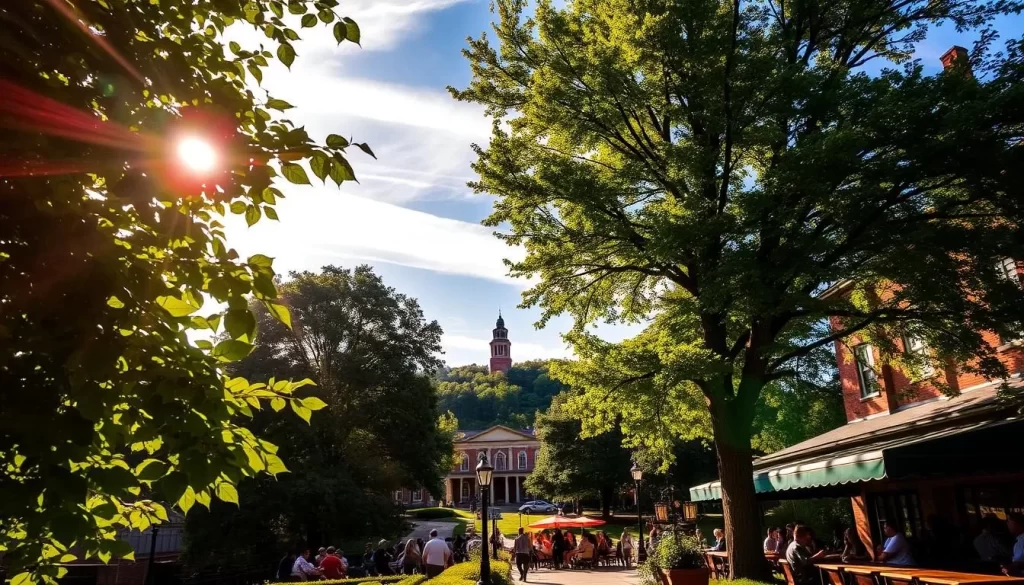
Understanding these patterns can help you plan your trip to Charlottesville during the summer months, ensuring you’re prepared for the weather conditions.
Fall in Charlottesville (September-November)
The arrival of fall in Charlottesville brings a perfect blend of comfortable weather and vibrant foliage, making it an ideal time to visit. As the summer heat dissipates, the city is painted with the warm hues of autumn, creating a picturesque landscape.
September’s Perfect Balance
In September, Charlottesville enjoys a perfect balance of warm days and cool nights, making it an excellent time for outdoor activities. The average high temperature is around 78°F, while the lows dip to about 58°F, providing a comfortable climate for exploring the city’s vineyards and scenic trails. As the month progresses, the summer crowds dissipate, allowing for a more relaxed experience at popular attractions.
October’s Fall Foliage
October is a highlight of the fall season in Charlottesville, with the foliage reaching its peak. The city’s surroundings are ablaze with color, as the trees don their finest hues of orange, red, and yellow. The average high temperature is around 68°F, with lows of about 50°F, making it an ideal time for hiking, vineyard tours, and enjoying the scenic beauty of the region. You can expect pleasant perceived temperatures during this time, making outdoor activities even more enjoyable.
November’s Cooling Trend
November marks the transition from fall to early winter conditions in Charlottesville, with a pronounced cooling trend throughout the month. You’ll experience average high temperatures around 59°F and lows near 40°F, with significantly colder conditions possible by month’s end. While the foliage may begin to fade, the landscape takes on a serene beauty, and the cooler weather is ideal for exploring indoor attractions or enjoying the city’s many cultural events. It’s a good time to visit if you prefer fewer tourists and lower prices, making it a great time to visit for those on a budget.
As the cloudier part of the year begins around November 13, you can expect more overcast days, but precipitation remains relatively low, with about 6-7 days of rainfall totaling approximately 3 inches. There’s also a possibility of the season’s first light snow by late November, adding to the city’s winter charm.
Winter in Charlottesville (December-February)
As winter sets in, Charlottesville transforms into a serene landscape, offering a unique experience for visitors. The winter season, spanning from December to February, brings chilly temperatures and occasional snowfall, creating a picturesque scenery that is perfect for a winter getaway.
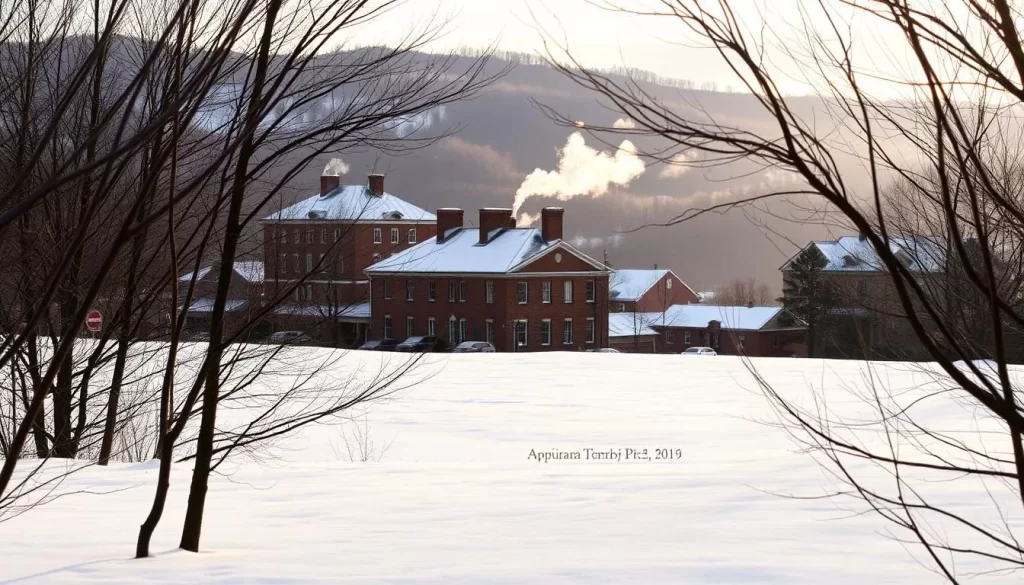
December Holiday Weather
December marks the beginning of winter in Charlottesville, with average high temperatures around 48°F (9°C) and lows near 30°F (-1°C). The holiday season brings a festive atmosphere to the city, with mild winter conditions making it ideal for outdoor activities like strolling through the historic downtown area or visiting local vineyards. There’s a chance of precipitation, with an average of 3.5 inches (89 mm) of rain or snow.
January’s Cold Snap
January is typically the coldest month in Charlottesville, with average highs around 45°F (7°C) and lows near 26°F (-3°C). While it’s not uncommon for the temperature to drop significantly, the city’s weather stations usually record moderate snowfall. January averages about 3.6 inches of snow, adding to the winter wonderland ambiance. When snow does fall, it often remains on the ground for several days, creating a beautiful landscape.
February Snow Possibilities
February is the month with the most snow in Charlottesville, averaging about 5.4 inches of snowfall. The temperatures remain chilly, with highs around 50°F (10°C) and lows near 32°F (0°C), and there’s considerable day-to-day variability. The chance of precipitation remains similar to January, at about 15%, with approximately 6-7 days of measurable precipitation throughout the month. When snow falls, it typically stays on the ground, creating scenic winter landscapes that are perfect for outdoor activities like hiking or exploring the city’s historic sites.
Overall, winter is a great time to experience Charlottesville’s serene beauty, with its mild temperatures and occasional snowfall making it an ideal destination for those looking to escape the hustle and bustle of city life.
Charlottesville, Virginia: Best Months for a Weather-Savvy Trip
To make the most of your Charlottesville trip, understanding the local climate and identifying the best months to visit is crucial. The city’s weather varies significantly throughout the year, impacting the quality of your travel experience.
Prime Time: September to Early October
The period from September to early October is considered prime time for visiting Charlottesville. During this time, the weather is generally mild and pleasant, with comfortable temperatures ranging between 65°F and 80°F (18°C to 27°C). This makes it ideal for outdoor activities such as hiking, visiting vineyards, and exploring the city’s historic sites. The tourism score, which takes into account factors like temperature, cloud cover, and precipitation, peaks during the first week of September, indicating perfect weather conditions for tourists.
Runner-Up: Late May to June
Late May to June is another excellent period to visit Charlottesville. The weather during this time is characterized by mild temperatures and lower humidity, making it suitable for outdoor activities. June scores highly on the tourism scale, offering excellent conditions before the peak summer heat and humidity arrive. Visitors can enjoy the city’s scenic beauty, visit historical landmarks, and participate in outdoor events without the discomfort of extreme weather.
Weather-Based Tourism Score
The weather-based tourism score is a valuable tool for determining the best times to visit Charlottesville. It favors clear, rainless days with perceived temperatures between 65°F and 80°F (18°C to 27°C). Based on this score, the best times to visit are during the entire month of June and from early August to early October, with a peak score in the first week of September. Understanding this score can help you plan your trip to coincide with the most comfortable weather conditions for your preferred activities.
| Month | Average High Temperature (°F) | Average Precipitation (inches) | Tourism Score |
|---|---|---|---|
| May | 75 | 4.2 | 6 |
| June | 84 | 3.8 | 8 |
| September | 78 | 3.5 | 9 |
| October | 68 | 3.2 | 7 |
By considering the tourism score and the factors it encompasses, you can make informed decisions about the best time to visit Charlottesville, ensuring a memorable and enjoyable trip.
Worst Times to Visit Weather-Wise
To make the most of your trip, it’s crucial to know the worst times to visit Charlottesville weather-wise. While the city is beautiful year-round, certain periods present weather challenges that can impact your travel plans. Understanding these periods can help you prepare and make informed decisions about your trip.
July’s Heat and Humidity Challenges
July is one of the most challenging months to visit Charlottesville due to its sweltering heat and high humidity. Average highs often reach the mid-80s to low 90s Fahrenheit (30-32°C), making outdoor activities uncomfortable. The humidity can make the temperature feel even hotter, potentially leading to heat exhaustion if you’re not careful. If you’re sensitive to heat, consider avoiding July or plan for indoor activities during the hottest parts of the day.

Winter Weather Considerations
Winter months, from December to February, present another set of weather challenges for visitors. Cold temperatures are common, with average highs ranging from the 40s to 50s Fahrenheit (4-10°C) and lows frequently below freezing. Snow is possible throughout these months, with February typically seeing the most significant snowfall, averaging 5.4 inches. While snow can add a picturesque layer to the city, it can also impact travel conditions, especially in more rural areas around Charlottesville. The snowy period lasts for approximately 4.1 months, from November 21 to March 23, with a sliding 31-day snowfall of at least 1.0 inches. Be prepared for potential disruptions and colder conditions if you plan to visit during winter.
When visiting during winter, be aware that shorter daylight hours can limit your outdoor exploration time, with darkness falling as early as 5:00-5:30 PM. However, Charlottesville’s indoor attractions remain fully accessible and can provide a warm respite from the cold. Areas around the city, including rural stations on the ground, may experience varying weather conditions, so it’s wise to check forecasts before heading out.
Planning Around Precipitation
To make the most of your visit to Charlottesville, it’s essential to consider the precipitation patterns. Understanding when it’s likely to rain or snow can help you plan your activities and make the most of your trip.
Rainiest Months to Avoid
Charlottesville experiences its highest levels of precipitation during certain months. While the region doesn’t have a distinct dry season, some periods are wetter than others. You should be prepared for potential rain during the spring and summer months. Although specific monthly averages aren’t provided, it’s generally wise to check current weather forecasts before your trip to ensure you’re prepared.
Key Considerations:
- Spring showers are common, so packing an umbrella is a good idea.
- Summer storms can occur, sometimes bringing heavy rain.
Snow Considerations for Winter Travelers
For those visiting during the winter months, understanding snow patterns is crucial. The ground remains snowy for approximately 4.1 months, from November 21 to March 23. During this period, a sliding 31-day snowfall of at least 1.0 inches is expected.
- The snowy season spans approximately 4 months, with measurable snowfall possible throughout.
- February typically receives the highest average snowfall at 5.4 inches, though variability exists.
- Snow events are generally manageable, with major roads cleared quickly.
- Building flexibility into your itinerary is advisable to accommodate potential weather disruptions, particularly outside the city.
By understanding these precipitation patterns, you can better plan your week-long trip to Charlottesville, ensuring a more enjoyable experience regardless of the season.
Charlottesville Accommodations by Season
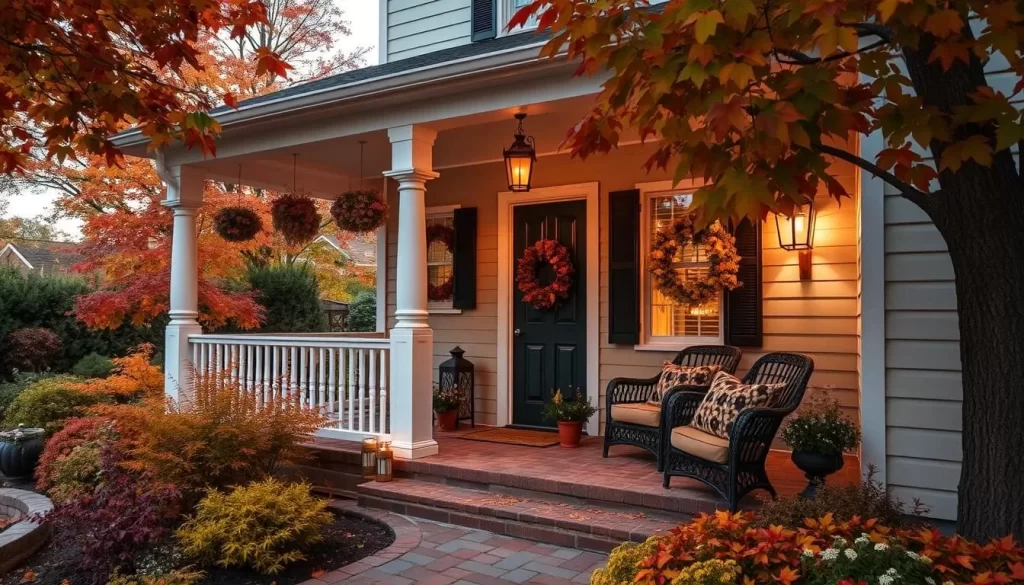
Charlottesville offers a diverse range of accommodations to suit various preferences and weather conditions throughout the year. From luxurious resorts to cozy bed and breakfasts, you can find the perfect place to stay that complements your travel plans and enhances your overall experience.
Peak vs. Off-Season Pricing
Accommodation prices in Charlottesville vary significantly depending on the season. During peak travel seasons, such as fall foliage and summer vacations, prices tend to be higher due to increased demand. In contrast, off-season periods, typically during the winter months, offer more competitive rates. If you’re on a budget, consider visiting during the off-season for better deals on lodging. You can enjoy a more relaxed atmosphere and potentially lower rates at popular stations and hotels.
Planning your trip during the shoulder season, like late spring or early fall, can also provide a good balance between comfortable weather and reasonable prices. During the day, you can explore the city’s attractions, and at night, enjoy the local cuisine and entertainment.
Weather-Appropriate Lodging Options
Charlottesville’s accommodations cater to different weather conditions, ensuring that you’re comfortable regardless of the season. For summer visits, opt for properties with swimming pools, air conditioning, and shaded outdoor areas to beat the heat. In the winter, choose lodgings with fireplaces and indoor amenities to stay cozy. Spring and fall travelers can enjoy properties with outdoor patios and gardens, making the most of the pleasant weather.
When traveling to Charlottesville, consider the time of year and your preferred travel style. Whether you’re looking for a luxurious getaway or a budget-friendly option, the city’s diverse range of accommodations has something for everyone.
Getting Around Charlottesville in Different Weather Conditions
Understanding how weather affects transportation in Charlottesville can enhance your travel experience. The city’s varied climate means that getting around requires some planning and flexibility.
Transportation Options by Season
Charlottesville offers various transportation options, but the suitability of each can vary with the weather. During the spring and fall, when the weather is generally mild, walking and cycling are pleasant ways to explore the city. In contrast, summer’s heat and humidity might make you prefer air-conditioned public transport or ride-sharing services. Winter’s chill and potential snow or ice may necessitate more cautious planning, potentially favoring personal vehicles or public transportation with good traction.
Public transportation, including buses, is available and can be a reliable option during inclement weather. Ride-sharing services are also widely used. For those driving, being aware of weather forecasts can help in planning routes and avoiding hazardous conditions.
Weather Impact on Driving Conditions
Weather conditions significantly impact driving experiences in and around Charlottesville. Summer thunderstorms can create temporary hazards with heavy rain reducing visibility and occasionally causing localized flooding on roadways. In the fall, wet leaves on roadways can reduce traction, particularly on rural and winding roads. Winter presents the most significant driving challenges, with even small amounts of snow or ice affecting road conditions, especially on secondary roads and in hilly areas.
| Season | Common Weather Conditions | Impact on Driving |
|---|---|---|
| Spring | Mild temperatures, occasional rain | Wet roads, potential for flooding |
| Summer | Heat, humidity, thunderstorms | Reduced visibility, localized flooding |
| Fall | Cooling temperatures, wet leaves | Reduced traction on leaf-covered roads |
| Winter | Cold, potential snow and ice | Hazardous road conditions, especially on secondary roads |
The Virginia Department of Transportation (VDOT) maintains a 24-hour Highway Helpline (800-367-7623) that provides current information about road conditions, particularly useful during winter weather events. Being aware of these conditions and planning accordingly can make your journey safer and more enjoyable.
Outdoor Activities and Weather Considerations
Charlottesville, Virginia, is a haven for outdoor enthusiasts, offering a diverse range of activities that cater to different weather conditions throughout the year. The city’s proximity to the Blue Ridge Mountains and Shenandoah National Park provides a unique backdrop for various outdoor pursuits.
Best Weather for Vineyard Tours
Vineyard tours are a popular activity in Charlottesville, with the best weather being a crucial factor for a pleasant experience. Clear, mild days with temperatures between 65°F and 80°F are ideal. Spring (April-May) and fall (September-October) are particularly suitable, offering comfortable temperatures and scenic beauty. During these periods, the foliage is lush, and the vineyards are either blossoming or harvesting, adding to the aesthetic appeal.
Hiking and Outdoor Recreation Timing
Charlottesville’s surroundings offer exceptional hiking and outdoor recreation opportunities year-round. The best time for hiking depends on your preferences: fall (September-October) for comfortable temperatures and stunning foliage, spring (April-May) for wildflower displays and rushing waterfalls, or early morning summer days to avoid heat and humidity. Even winter can be a good time for hiking on clear days, offering solitude and expansive views.
Indoor Attractions for Inclement Weather Days

The city’s rich cultural scene provides numerous indoor options for visitors to enjoy, regardless of the weather outside. Whether you’re looking for art, history, or entertainment, Charlottesville has a range of indoor attractions to suit your interests. You can spend your day exploring these indoor gems, having a great time without worrying about the weather.
Museums and Historical Sites
Charlottesville is home to several world-class museums and historical sites that are perfect for a rainy day. The University of Virginia campus, a UNESCO World Heritage Site, offers guided tours that take you through its historic buildings and beautiful gardens, even on a cold or rainy day. The Kluge-Ruhe Aboriginal Art Collection is another must-visit, featuring one of the largest collections of Aboriginal art outside Australia. You can easily spend a day or night exploring these cultural treasures.
For history buffs, the Charlottesville Visitor Center provides insight into the city’s past, while the Ash Lawn-Highland offers tours of its historic mansion. These sites not only provide shelter from the weather but also a deep dive into the area’s rich history, making your travel to Charlottesville a memorable experience.
Shopping and Dining Options
When the weather outside is not inviting, Charlottesville’s vibrant shopping and dining scene is the perfect alternative. The Downtown Mall is a pedestrian-friendly area filled with dozens of restaurants, boutiques, and shops, all within a covered or indoor environment. You can enjoy a leisurely time browsing through local boutiques, having a meal at one of the many eateries, or simply relaxing in a cozy café.
In addition to the Downtown Mall, the Barracks Road Shopping Center offers a mix of national retailers and local businesses, making it an ideal place to spend an afternoon, regardless of the weather outside. Charlottesville’s diverse dining scene, ranging from casual cafes to fine dining establishments, ensures that you can find something to suit your taste. Many restaurants feature seasonal menus that highlight local produce, providing a culinary experience that’s both satisfying and locally rooted. Whether you’re dining during the day or enjoying the evening entertainment options, such as theaters, music venues, and breweries, you’ll find that Charlottesville’s indoor areas have something for everyone.
Special Events and Weather Timing
To make the most of your visit to Charlottesville, you should be aware of the special events happening during your trip. Charlottesville’s event calendar is rich with festivals, university events, and cultural activities that can enhance your travel experience.

Festival Season Weather Considerations
The festival season in Charlottesville typically brings pleasant weather, making it an ideal time to visit. Many festivals take place in the spring and fall, when the weather is mild and comfortable. For instance, the Charlottesville Festival of the Arts usually occurs in May, a month known for its gentle temperatures and blooming flowers. You should plan your visit accordingly, as these events can attract large crowds and affect accommodation availability on a given day.
It’s also worth noting that some festivals are weather-dependent, so checking the forecast before heading out is a good idea. Overall, the festival season is a great time to experience Charlottesville’s vibrant cultural scene.
University of Virginia Events Calendar
The University of Virginia hosts numerous events throughout the academic year that can impact tourism and accommodation availability in Charlottesville. Move-in days in late August and graduation weekend in May create extreme demand for accommodations, with hotels often booked a year in advance. Home football games, primarily from September through November, draw large crowds, particularly for rivalry matchups, affecting both lodging availability and restaurant wait times.
Additionally, cultural events at the university, including performances at the John Paul Jones Arena and exhibitions at campus museums, offer weather-independent entertainment options throughout the academic year. Planning your visit around these events can help you avoid peak tourist peak season crowds and make the most of your trip.
Packing Tips for Charlottesville’s Variable Weather
Charlottesville’s variable weather demands a thoughtful approach to packing to ensure a pleasant visit. The city’s climate can vary significantly between day and night, particularly during the spring and fall seasons, making it essential to pack clothing that can be adjusted according to the changing perceived temperatures.
Seasonal Packing Lists
Creating a seasonal packing list can help you prepare for Charlottesville’s varying climate conditions. For spring and fall, include layers that can be easily added or removed as temperatures fluctuate. Even in summer, a light jacket or sweater can be useful for cooler evenings, especially near water or at higher elevations. Quick-drying fabrics are advisable year-round due to the possibility of rain.
- For spring (March-May), pack layers for temperature swings of up to 20-30°F.
- In summer (June-August), prioritize lightweight, breathable clothing, but include a light layer for cooler evenings.
- For fall (September-November), bring layers for significant temperature changes.
- In winter (December-February), pack warm clothing, including a heavy coat and gloves.
Layering Strategies for Changing Conditions
Mastering the art of layering is crucial for comfort during your Charlottesville visit. The basic three-layer system works well: a moisture-wicking base layer, an insulating mid-layer, and a weather-protective outer layer. This allows you to adjust your clothing throughout the day to suit the changing conditions. Even summer evenings can feel cool after hot days, making a light jacket or sweater a useful addition to your packing list.
Conclusion: Making the Most of Your Weather-Savvy Charlottesville Trip
Whether you’re looking for pleasant weather or specific activities, Charlottesville has something to offer every traveler. Planning a weather-savvy trip to Charlottesville means finding a balance between optimal weather conditions and your specific interests and activity preferences. The prime visiting windows of September to early October and late May to June offer the most reliable pleasant weather for a wide range of activities.
Based on the tourism score, the best times of year to visit Charlottesville for warm-weather activities are for the entire month of June and from early August to early October, with a peak score in the first week of September. This information can help you plan your trip during the most favorable periods.
Even during less ideal weather periods, Charlottesville’s diverse attractions ensure enjoyable experiences with proper planning and flexible itineraries. Understanding seasonal patterns allows you to pack appropriately, schedule weather-dependent activities strategically, and set realistic expectations for your visit. For instance, summer offers vineyard concerts, while fall brings stunning foliage, spring showcases beautiful blooms, and winter provides cozy retreats.
Ultimately, each season in Charlottesville offers unique charms and experiences. By considering the weather and planning accordingly, you can make the most of your trip and enjoy all that Charlottesville has to offer. So, when is the best time to visit Charlottesville? It depends on your preferences, but with this guide, you’re well-equipped to make an informed decision and have a wonderful travel experience in this beautiful Virginia city.
The above is subject to change.
Check back often to TRAVEL.COM for the latest travel tips and deals.


